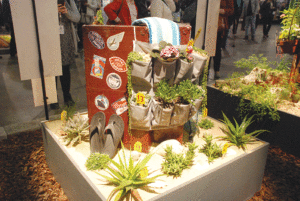
A pocket garden can be as simple and inexpensive as a shoe bag such as this one displayed at the Philadelphia Flower Show in March. Just tuck in plastic pots with plants where the shoes are supposed to go. Succulents will require minimal watering. As for the African violets on the top row, they make good indoor plants, but won’t survive outdoors like common violets. Still, a plastic pot is easily popped into or out of a container such as this and might be used temporarily on a special occasion to provide a pop of color. (Photo by Carol Kinsley)
While big, showy displays may have garnered the most attention at the Philadelphia Flower Show in March, few of them are reproducible in your own garden space without the help of a professional landscaper.
One class of entries in the 191st year of the show put on by the Pennsylvania Horticultural Society, however, would be easy to replicate: Pocket Gardens.
Pocket gardens are bright displays in small spaces, as in the minimum required spacing between houses in a development or in containers on a small patio or balcony.
They provide a “wow factor” of color and texture in an otherwise bare space.
A pocket garden can be as simple as a few tiny plants tucked into a stone wall or a series of large planters full of ornamental grasses and trailing vines.
The Shipley School Sprouts, a private school garden club entered the show, as it has for some 35 years, taking a blue ribbon in the Pocket Garden Class with a tabletop garden of succulents such as one might find on a green-roofed cabana in coastal areas of the Mediterranean.
Several years ago, the club won a wealth of ribbons for what might be considered another pocket garden: “A Sink of Dirty Dishes,” complete with faucet and succulents tucked among plates and kitchen utensils.
Imagine, if you are fortunate enough to have an old-fashioned hand water pump, combining that with a recycled kitchen sink, plants and even broken pieces of china, with the broken edges hidden in the soil.
Or consider a pocket garden in an old wheelbarrow, bushel basket, a child’s “little red wagon,” or a cracked birdbath.
Just remember that the amount of soil, and therefore, growing space, is limited. Don’t over fertilize or overwater.
For hanging on a fence or door post, you can find “hanging grow bags” or “flower pouches” available on the Internet.
Or, copy the idea of another entry in the Pocket Garden Class at the Philadelphia Flower Show and use a hanging shoe bag.
Most have room for small plastic pots to be inserted with a plant.
If you don’t mind getting the bag dirty, you can cut out the bottom of the pot and add soil beneath it to give the roots more room.
You can hide the plastic container, if you wish, with mulch, moss or pebbles.




